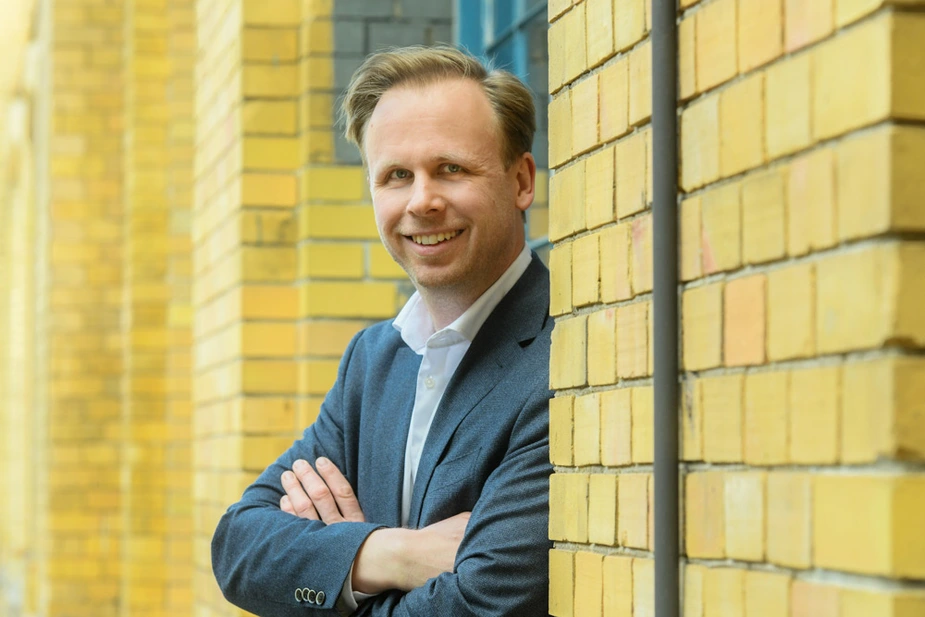Awoken from a slumber – how inventors bent on the future mix with developers ready to invest
Gregor Keck, head of the regional management agency for Berlin’s South East region, about happy investors, shared identities, and a lively industrial culture
How do you define, what we call, a ‘Zukunftsort’, a place where future innovation is created?
It is a place where scientists and businesses get together, which especially includes companies that plan and execute their business together with universities. A ‘Zukunftsort’ needs spaces facilitating growth that are either already on the market, ready for development, or being developed. This can include technology centres or building land that are at the disposal of manufacturing companies and service companies geared towards manufacturing. This mix is made whole by the creative industry, artists, and culture.
What does this mean in Schöneweide?
Schöneweide has lots of room. Former industrial estates that were stuck in so-called interim use and whose owners have now sold them off at great profit. The area has attracted many companies as well as the creative industry. Many work closely together with HTW Berlin, the University of Applied Sciences for Engineering and Economics.
Can you define Schöneweide as a ‘place of future innovation’ in geographic terms?
It spans the former industrial belt along Ostendstrasse, Wilhelminenhofstrasse, and up to Nalepastrasse, including the area around Funkhaus, the former East German broadcasting centre. It borders on the Spree river to the south. We also include the commercial areas on Niederschöneweider Ufer, the premises of the former Bärenquell brewery as well as the Schöneweide train station.
What does the regional management agency do?
Our task is to bring people together – the universities with companies, district-level policymakers, but also newer stakeholders, for example, large area developers. ‘Zukunftsorte’ are all about a shared identity, not a fabricated one but one that is deep-felt by all the area’s stakeholders. The region’s history is full of ups and downs, for example, the debate about developing residential areas along the industrial belt. With the drawing up of the latest development plans, this is now a thing of the past. The area is going to be used commercially and with a focus on science.
Maybe this is a good time to look back?
Last year was a great year. The new investors on the 10-hectare large and partly listed industrial areas are committed to the region in the long term. There will be some major changes. During this process of transformation, which we have been looking forward to for years, we are serious about bringing everyone with us. Attracting new companies to Schöneweide, our focus is on those matching the departments of HTW Berlin. Our network has extended well beyond Schöneweide. The BER airport is now being opened and we are right in the middle of that south-east development corridor.
Schöneweide used to be known as ‘Elektropolis’.
The area is full of impressive relics from that time, including the three-phase-current plant on Wilhelminenhofstrasse, which is now being revived by artists and the creative industry, or the Rathenauhallen, which will soon again be home to industry. The Peter-Behrens-Bau building and the Werk für Fernsehelektronik, a former television electronics factory, are going to be completely refurbished for technology-focused companies. Regarding the business sectors we are aiming at, there are also many links to the old ‘Elektropolis’, including sensor technology and electrical engineering, construction of vehicles, machines and tool, energy technology, cable manufacturing, and high technology for top-class sports. It was important to us to create an avantgarde of companies settling in the area. Many of our companies are market as well as technology leaders in their fields. So, the ‘Elektropolis’ is still brimming with the spirit of invention and is bent on the future.
What will happen when the regional management project ends in August 2020?
Soon, HTW Berlin will have moved its entire departments to the area. This is key for the project to work. The region has awoken from a slumber. We are now attracting more investment than Siemensstadt. We are also bringing the issue of access to the waterways to the table. Unfortunately, the potential of Schöneweide’s waterways connection is yet to be used. We are calling for a water-based traffic solution to relieve the pressure on roads. The district’s administration is currently working on reconfiguring management of the TGS (Technology and Start-Up Centre ‘Spreeknie’). They are thinking about setting up the regional management agency there.
Where do you see the biggest challenges?
First: traffic. Once it’s fully developed, the region could attract more than 10,000 new jobs in the next ten years. We have been tirelessly lobbying for building an additional bridge over the Spree river, the Wilhelminenhof Bridge, which is extremely important for connecting Niederschöneweide with the S-Bahn station Oberspree as well as Adlershof.
Secondly: marketing and PR for the region. We can only act together if we know who we are and where we want to go.
Third: maintaining our portfolio. We must make sure that the companies that succeed here can continue succeeding.
Fourth: schooling possible investors. How does the district tick, what is Schöneweide, how does this place work? Creating connections and consensus, creating understanding for the benefit of the location.
Interview by Rico Bigelmann and Sylvia Nitschke for Potenzial – The WISTA Magazine
Zukunftsort Berlin-Schöneweide
- Total area: approx. 130 ha
- Businesses: approx. 370
- Staff: over 3,000
- Creatives and artists: approx. 400
- Key figures of the University of Applied Sciences for Engineering and Economics
- Students: approx. 14,000, in Schöneweide > 9,000
- -Professors: approx. 300
- -Lecturers: 800
- Head of the regional management agency: Dr. Gregor Keck
- Management:
Regional Management Berlin South-East
Ostendstr. 25, 12459 Berlin
Phone: +49 30 53041110 | info(at)suedost-berlin.de - schoeneweide.com
- suedost.wista.de
